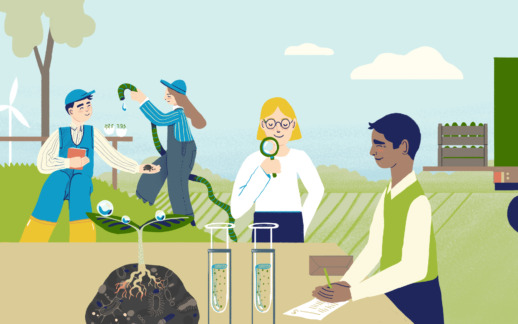Systemic change – what does it mean? CARBON ACTION AS AN EXAMPLE
The major goal of the Carbon Action platform is a systemic change toward regenerative agriculture. This change also plays a central part in the efforts to achieve a carbon-neutral society and a sustainable food system.
We have made very good progress in Carbon Action – relying heavily on research and working closely with key stakeholders. Our aim is to achieve systemic change. But what does this mean? Could systemic change be described with the help of a picture?
Whenever I think about systemic change, I am reminded of a presentation by Per Mickwitz, a former research director colleague at Finland’s environmental administration. He presented a model created by Geels and Schot (Figure 1). The model highlights how we need to proceed step by step – as long as the steps lead in the right direction. Systemic change is a challenge of such magnitude, that we must go about it one step (or project) at a time. As long as we keep the big picture in mind and stay on the right path toward our goal:

Figure 1. A multi-level perspective on socio-technical transitions. According to the model, the interaction between the landscape, regime, and niche innovations allows for system change. The incompatibility of the landscape and regime acts as a “driver” that creates pressure for regime reform and the breakthrough of new innovations at the regime level. (source: original Geels & Schot 2007).
How would this apply to the Carbon Action platform? In their outstanding report, Valovirta et al. 2011 have applied the model. Utilizing their report, I applied the model to Carbon Action.
The model consists of three dimensions
- dimension: regime: a set of policies, interpretative frameworks, and problem-solving models that are considered self-evident. The regime can be divided into five dimensions: A technological regime (self-awareness of actors such as companies: what we are, and why we are doing the things we do), science regime (rules and policies of the science system), policy regime (administrative models), socio-cultural regimes (societal values), user and market regimes (rules for the market formation and creation). In the Carbon Action model, the regime consists of agriculture in the broadest sense – the goal being a shift from the conventional agricultural model to a regenerative model.
- dimension: landscape that includes a wide range of societal developments. The regime’s operating models are not necessarily compatible with the changing landscape. The landscape may thus affect the regime in a way that opens a “window of opportunity” for efforts to reform the regime or even form an entirely new regime. Big ecological drivers for change (VNK 2019) in Carbon Action are climate change, the state of the environment and nature, and the sustainability of natural resource use.
- dimension: the development of new models of operating outside the current regime. As these new models strengthen and merge with other parallel reform efforts, they may form a “dominant model” that can change the prevailing regime as the “window of opportunity” opens. In the Carbon Action model, this includes the projects and activities of the Carbon Action platform, as well as other parallel activities aimed towards regenerative agriculture. Cooperating on a large scale with other stakeholders and influencing decision-making are also parts of the Carbon Action operating model. BSAG coordinates the Carbon Action platform, aiming to support and steer the various projects and activities of the platform in the same direction – to ensure we stay on the path.
It is also good to note that the regime is constantly “dynamically stable” (Nieminen et al. 2011). Even within the regime, in this case in conventional agriculture, constant renewal is present. However, renewal within the regime does not necessarily change the patterns, values, and beliefs that make up the regime, but rather adapt it to the ever-changing landscape. The regime may then also assimilate new insights and practices from the outside, but the changes will take place within the framework defined by the prevailing regime. My interpretation is, that at the moment, we are at that stage.
At some point, however, the operation of the regime and the changes in the landscape may come to a broader state of incompatibility, bringing the whole regime into crisis. This opens up a “window of opportunity” for the development of a new regime. In the Carbon Action model, I set the goal that change has been achieved by 2035 in Finland – which is the year that Finland aims to become carbon neutral (Figure 2).
To be able to comprehend what the change means, all three levels need to be taken into account (Nieminen et al. 2011). The aim is that small changes in the system lead to large-scale changes at the system level over a longer period. What is essential is to enable interaction, communication, and mutual learning between stakeholders inside and outside the regime. The more stakeholders are involved and committed, the more defined the path towards change becomes. This is the strength of the work carried out on the Carbon Action platform. Stakeholders on the Carbon Action platform – farmers, advisors, researchers, companies, and decision-makers – learn together and co-create. Cooperation with international regenerative agriculture networks is also important. Systemic change in the field of agriculture is in progress globally.
The path of change must be based on research data. An example of this is the development of a scientifically ambitious measurement and verification system in Carbon Action. The system can help us determine the amount of carbon stored in the soil. The verification of changes in the carbon stocks makes it possible for farmers to monitor how these cultivation methods affect the soil. Companies in the food supply chain are interested in the carbon footprint of production. On a societal level, scientific verification provides a basis for agricultural and climate policy instruments and a possible carbon credit market.

FIGURE 2. Carbon Action interpreted through a model of socio-technical change (adapted from Geels & Schot 2007)
It’s important to make sure that the steps taken are effective enough – so that we are able to scale up the actions. Bottlenecks also need to be identified and addressed. On the Carbon Action platform, we identified that training skillful advisors had become a bottleneck in our work. Together with the support of Maa- ja vesitekniikan tuki and other key actors, we launched a targeted training for agricultural advisors. We have gained new carbon farmers through business cooperation (see below) and through the Carbon Action Club – which is open for all farmers – and by expanding towards the Swedish-speaking farmers in Finland. The lack of resources is often a hindrance for face to face meetings and information exchange. That is why we are also developing platforms for digital learning. We will start working on digital learning on a larger scale this autumn. It is a big step forward.
To bring about systemic change, the Carbon Action business platform is key. Through their actions, companies can guide both the work of farmers and consumer choices. For example, Valio trains its dairy farmers to become carbon farmers. Also, the sourcing of raw materials will change extensively as companies bring the principles of carbon farming into their sourcing criteria – as Apetit and Fazer have committed to do.
Systemic change is also based on interaction and co-development with global pioneering networks. Carbon Action has been well noticed as part of the forerunner networks. For example, Carbon Action has been invited to speak at the EU Round Table in Brussels, and the Madrid Climate Conference (4/1000 initiative event). This year, of course, the corona situation has posed its challenges – international cooperation has been promoted through distance meetings.
What are the big challenges on our path? The biggest challenge seems to be to change the policy regime – especially agricultural policy. We are putting a lot of effort into this on many levels, but changing it requires patience and persistence. Changes are slow and there are many obstacles along the way.
Laura Höijer
Content Director, Baltic Sea Action Group
REFERENCES:
Carbon Action/stn MULTA project impact reports (in Finnish)
Geels, F. W. & Schot, J. 2007. Typology of sociotechnical transition pathways. Research Policy 36, 399–417.
Nieminen, M., Valovirta, V. & Pelkonen, A. 2011. Systemic innovations and socio-technological change. Literature review. VTT Releases – Research Notes 2593 (abstract in English)
Valovirta, V., Nieminen, M., Pelkonen, A., Turkama, P., Heikura, T., Lindman, J., Inkinen, S. & Kaivo-oja, J. 2011. The challenges of systemic changes and possibilities of new innovation. Tekes Review 286/2011. Tekes (Business Finland) (abstract in English)
VNK (Prime Minister’s Office) 2019. Drivers for change in the global environment, The drivers for change cards



